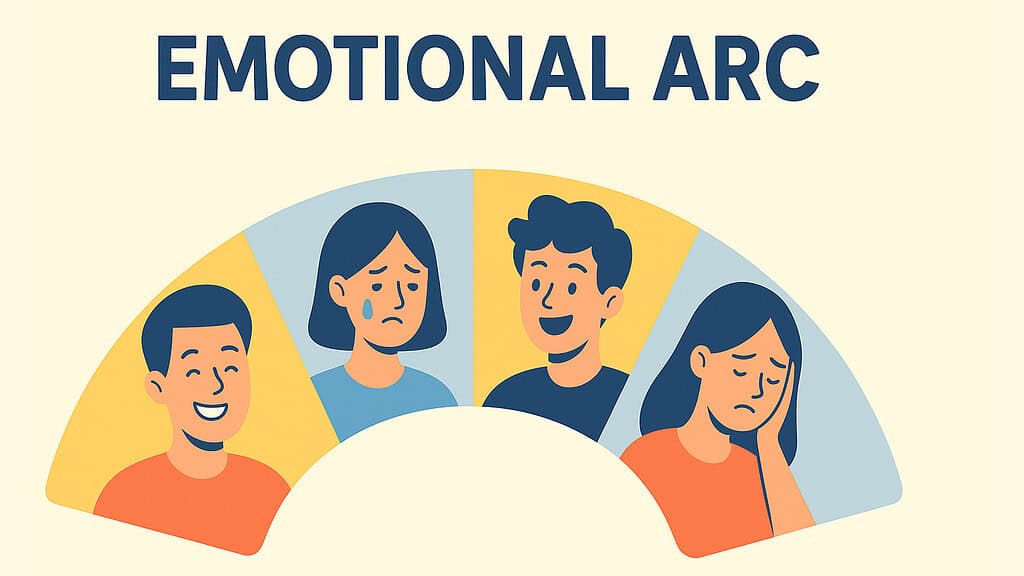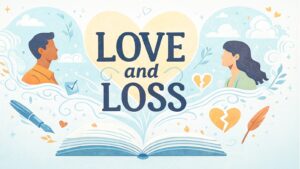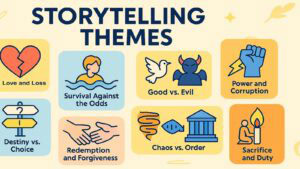Table of Contents
Introduction: Why Emotional Arc Is the Hidden Power of Storytelling

When Shakespeare penned Hamlet’s tragic descent or Disney crafted Simba’s journey from exile to kingship, they tapped into something deeper than mere plot mechanics. They understood that stories live and die by their emotional arc—the invisible thread that pulls audiences through laughter, tears, hope, and despair. While writers obsess over clever twists and memorable characters, the emotional arc remains the true architect of audience connection.
Think of emotional arc as the heartbeat of storytelling. It pumps life through every scene, every dialogue exchange, every moment of silence. Unlike other storytelling psychologies that focus on surface engagement, emotional arc works at a primal level. Where narrative hooks grab attention for moments and suspense keeps readers turning pages, emotional arc creates lasting bonds between audience and story.
The relationship between emotional arc and other storytelling psychologies reveals its unique power. Narrative hooks act as the primary attraction, pulling readers into the narrative’s sphere. The mirror effect helps audiences see themselves reflected in characters and situations. Suspense creates tension through uncertainty about future events. World immersion transports readers into believable fictional spaces. Twist and reframe techniques surprise audiences by subverting expectations. Yet emotional arc transcends all these approaches by targeting the audience’s emotional core rather than their intellectual curiosity.
Consider how emotional arc differs from these other techniques in its approach to audience engagement. While a narrative hook might use shocking statistics or provocative questions, emotional arc builds gradually through character struggles and triumphs. Where suspense relies on withholding information, emotional arc shares the character’s internal journey openly. World immersion creates believable settings, but emotional arc makes audiences care what happens within those settings.
This article explores six fundamental emotional arc patterns that have shaped storytelling across cultures and centuries. From the triumphant rise of rags-to-riches tales to the complex tragedy of fall-rise-fall narratives, these patterns form the emotional DNA of memorable stories. Understanding them reveals why certain stories resonate across generations while others fade into obscurity.
Emotional Arc Versus Other Storytelling Psychologies
| Storytelling Psychology | Primary Function | Emotional Engagement Level | Duration of Impact |
|---|---|---|---|
| Emotional Arc | Creates deep emotional journey | Profound and sustained | Long-lasting memory formation |
| Narrative Hook | Captures initial attention | Moderate and immediate | Brief engagement window |
| Mirror Effect | Reflects audience experiences | Personal and relatable | Medium-term connection |
| Suspense | Maintains uncertainty tension | Intense but temporary | Short to medium duration |
| World Immersion | Builds believable environments | Sensory and atmospheric | Variable based on execution |
| Twist and Reframe | Surprises through revelation | Sudden and cognitive | Brief shock value |
1. Emotional Arc of Rising Fortunes – Rags to Riches
The rags-to-riches emotional arc represents humanity’s most cherished narrative dream. From Cinderella to Slumdog Millionaire, these stories trace an upward trajectory that mirrors our deepest aspirations for transformation and success. This pattern doesn’t merely chronicle external advancement; it captures the internal metamorphosis that occurs when individuals overcome seemingly insurmountable obstacles.
Vladimir Propp’s analysis of folktale morphology reveals why rising fortune narratives possess such universal appeal. His structural framework identifies recurring functions within folktales that correspond perfectly to the emotional beats of rags-to-riches stories. The protagonist starts in a condition of deficiency or malevolence, acquires magical aid or uncovers latent abilities, encounters challenges that evaluate their merit, and ultimately undergoes a transformation through ethical integrity rather than sheer fortune.
Modern interpretations of this emotional arc maintain Propp’s essential structure while adapting to contemporary contexts. Rocky Balboa’s evolution from an obscure boxer to a heavyweight contender adheres to the traditional narrative of initial hardship, enchanted support via Mickey’s coaching, challenges faced in the ring, and final metamorphosis through determination. The emotional trajectory resonates as viewers feel a sense of vicarious victory through the protagonist’s achievements.
The psychological power of rising fortune narratives lies in their ability to validate the human belief in possibility. They suggest that current circumstances need not define future potential. This optimistic worldview resonates particularly strongly during times of economic hardship or social upheaval, when audiences seek reassurance that improvement remains within reach.
However, effective rags-to-riches stories require more than simple wish fulfillment. The most compelling examples ground their emotional arcs in authentic struggle and meaningful sacrifice. The protagonist must earn their transformation through genuine effort rather than convenient coincidence. This authenticity creates emotional investment that transcends mere escapism.
Contemporary has evolved the rags-to-riches emotional arc to address modern concerns about success and fulfillment. Stories like The Pursuit of Happyness explore not just material advancement but emotional and spiritual growth. The arc becomes less about acquiring wealth and more about discovering personal worth and family connection.
Propp’s Functions Applied to Rags-to-Riches Emotional Arc
| Propp’s Function | Emotional Arc Stage | Example from Classic Literature | Modern Film Example |
|---|---|---|---|
| Initial Lack | Protagonist’s humble beginnings | Oliver Twist’s orphanage | Rocky’s Philadelphia neighborhood |
| Call to Adventure | Opportunity for change | Great Expectations inheritance news | Karate Kid’s move to California |
| Magical Helper | Guidance or assistance | Fairy Godmother in Cinderella | Mr. Miyagi’s mentorship |
| First Trial | Initial challenge overcome | David facing Goliath | Daniel-san’s first tournament |
| Transformation | Character growth through adversity | Jane Eyre’s moral development | Andy’s prison experience in Shawshank |
| Final Victory | Achievement of new status | Elizabeth Bennet’s marriage | Pursuit of Happyness job acquisition |
2. Emotional Arc of Falling Fortunes – The Tragedy
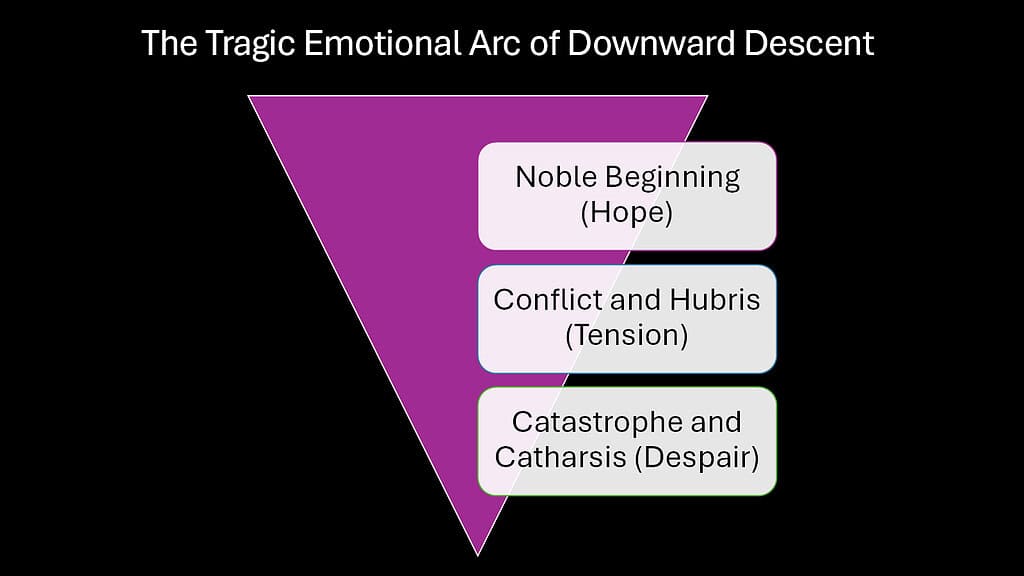
The tragic emotional journeys found in literature often result in some of the most lasting and impactful experiences. Unlike the uplifting journey of rags-to-riches narratives, tragic arcs trace a downward trajectory that culminates in loss, defeat, or death. Yet audiences return to these stories repeatedly, drawn by their profound emotional catharsis and insight into human frailty.
The tragic emotional arc operates through a fundamental paradox. While audiences naturally prefer happy endings, they find deep satisfaction in witnessing noble characters face inevitable doom. This satisfaction stems not from sadistic pleasure but from the recognition of universal human vulnerabilities. Tragic protagonists often possess admirable qualities that ultimately contribute to their downfall, creating complex emotional responses that simple heroic narratives cannot achieve.
Classical tragedy established many conventions that modern storytelling continues to follow. The tragic hero begins in a position of prominence or potential, possesses a fatal character flaw, makes critical errors in judgment, faces mounting consequences, and ultimately suffers a catastrophic fall. This structure creates emotional tension between audience sympathy and moral judgment.
The psychological appeal of tragic emotional arcs lies in their ability to process difficult emotions safely. By witnessing fictional suffering, audiences can explore themes of mortality, injustice, and loss without experiencing personal trauma. This vicarious processing serves important psychological functions, allowing individuals to confront fears and uncertainties within a controlled narrative framework.
Modern tragedy has expanded beyond classical conventions to address contemporary concerns. Stories like Breaking Bad trace the corruption of fundamentally decent characters through incremental moral compromises. The emotional arc becomes more complex as audiences simultaneously sympathize with and condemn the protagonist’s choices.
The tragic emotional arc also serves important social functions by highlighting systemic problems and moral dilemmas. Films like Requiem for a Dream use downward character trajectories to critique addiction, poverty, and social neglect. The emotional impact drives audiences toward greater awareness and potentially positive action.
Types of Tragic Emotional Arcs in Literature and Film
| Tragic Arc Type | Character Starting Point | Fatal Flaw | Downfall Trigger | Example Work |
|---|---|---|---|---|
| Classical Hubris | Noble or heroic position | Excessive pride | Defiance of gods/fate | Oedipus Rex |
| Moral Corruption | Ordinary decent person | Greed or ambition | Compromise of values | Macbeth |
| Circumstantial Victim | Innocent protagonist | Trust or naivety | External manipulation | Othello |
| Social Tragedy | Representative everyman | Systemic vulnerability | Institutional failure | Death of a Salesman |
| Psychological Unraveling | Mentally fragile character | Internal instability | Stress or revelation | Black Swan |
| Sacrificial Noble | Heroic idealist | Unwavering principles | Corrupt environment | A Man for All Seasons |
3. Emotional Arc of Fall and Rise – The Man in a Hole
The fall-and-rise emotional arc, often called the “man in a hole” pattern, represents one of storytelling’s most psychologically satisfying structures. This pattern traces a character’s journey from stability through crisis to eventual recovery and growth. Unlike simple rags-to-riches narratives, these stories emphasize resilience and redemption rather than initial disadvantage and advancement.
Aristotle’s concepts from Poetics provide valuable insight into why fall-and-rise arcs create such powerful emotional responses. His ideas about pity and fear in dramatic works apply directly to this pattern. Audiences feel pity for the protagonist’s undeserved suffering during the fall phase and fear that similar misfortunes could befall anyone. The subsequent rise creates catharsis as these negative emotions resolve into relief and admiration.
The psychological appeal of fall-and-rise narratives stems from their reflection of common human experience. Most people encounter significant setbacks, failures, or losses during their lives. Stories that demonstrate recovery from such experiences provide hope and practical models for resilience. The emotional arc suggests that temporary defeat need not become permanent defeat.
Effective fall-and-rise stories require careful attention to the relationship between the fall and subsequent rise. The descent must feel genuinely threatening while the recovery appears earned rather than convenient. Protagonists typically gain wisdom, strength, or perspective during their lowest moments that enables their eventual triumph. This growth makes the final victory more meaningful than their original status.
Modern narrative techniques have enhanced the emotional trajectory of fall-and-rise to align with contemporary psychological insights. Stories now explore trauma recovery, addiction rehabilitation, relationship repair, and career rebuilding with greater nuance and authenticity. The arc becomes less about external restoration and more about internal healing and growth.
The timing and pacing of fall-and-rise narratives significantly impact their emotional effectiveness. The fall must occur early enough to allow sufficient time for meaningful recovery, while the rise should feel gradual and believable rather than sudden and miraculous. This careful calibration creates sustained emotional engagement throughout the story.
Aristotelian Elements in Fall-and-Rise Emotional Arcs
| Aristotelian Concept | Application in Fall-and-Rise Arc | Emotional Function | Example from Literature/Film |
|---|---|---|---|
| Pity (Eleos) | Audience sympathy for undeserved suffering | Creates emotional investment | Job’s trials in biblical narrative |
| Fear (Phobos) | Recognition of vulnerability | Generates tension and relatability | It’s a Wonderful Life’s financial crisis |
| Catharsis | Emotional release through resolution | Provides psychological satisfaction | Les Misérables Jean Valjean’s redemption |
| Hamartia | Character flaw contributing to fall | Adds complexity and realism | Scarlett O’Hara’s selfishness in Gone with the Wind |
| Anagnorisis | Recognition or discovery | Enables character growth | Elizabeth Bennet’s pride revelation |
| Peripeteia | Reversal of fortune | Creates dramatic turning point | King Lear’s loss and eventual insight |
4. Emotional Arc of Rise and Fall – The Icarus Pattern
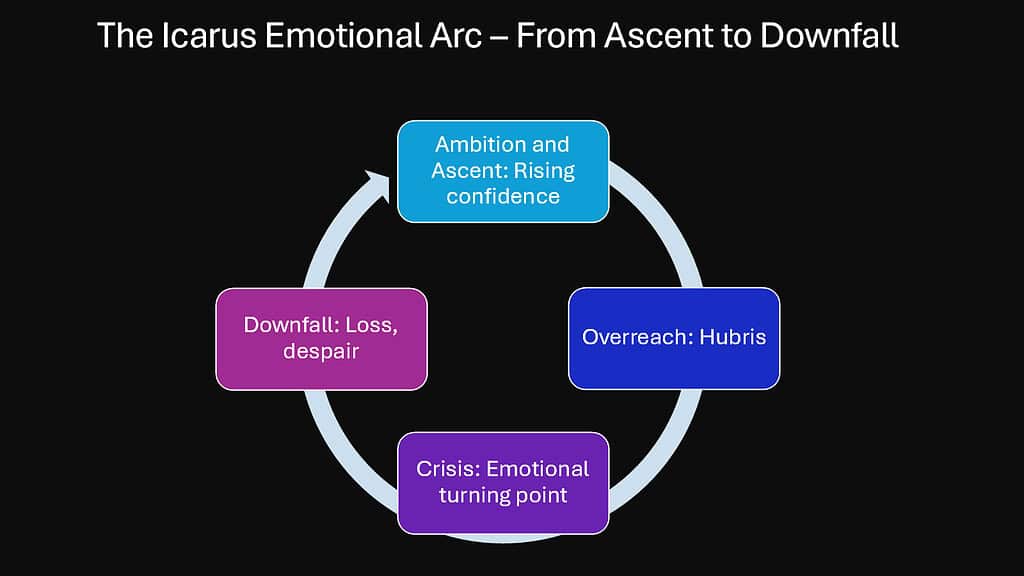
The rise-and-fall emotional arc, epitomized by the mythological figure of Icarus, explores the dangerous territory between ambition and hubris. This pattern traces characters who achieve great heights before experiencing catastrophic downfall, often due to their own success-induced blindness. Unlike pure tragedy, which may involve innocent victims, the Icarus pattern typically focuses on protagonists whose achievements directly contribute to their destruction.
The psychological fascination with rise-and-fall narratives reflects humanity’s complex relationship with success and power. Audiences simultaneously admire ambitious characters and anticipate their downfall, creating a tension that drives emotional engagement. This pattern acts as a celebration of human potential while simultaneously serving as a cautionary warning regarding the perils of unrestrained ambition.
Contemporary understandings of the Icarus pattern have progressed beyond mere moralistic cautionary narratives. Contemporary stories explore the psychological pressures of success, the isolation that accompanies achievement, and the corrupting influence of power. Characters like Harvey Dent in The Dark Knight or Daniel Plainview in There Will Be Blood demonstrate how success can fundamentally alter personality and values.
The rise-and-fall emotional arc operates through careful escalation of both achievement and character flaws. Early successes mask developing weaknesses while creating conditions that will ultimately trigger downfall. This structure creates dramatic irony as audiences recognize dangers that characters cannot see. The emotional impact comes from witnessing the slow-motion destruction of initially admirable figures.
The timing of revelation and downfall significantly affects audience emotional response. Too rapid a fall feels unsatisfying, while overly prolonged decay becomes tedious. The most effective rise-and-fall arcs allow sufficient time for audiences to invest in the character’s success before revealing the psychological or moral costs of that achievement.
Contemporary society’s fascination with celebrity culture has created new contexts for exploring rise-and-fall emotional arcs. Stories about musicians, athletes, politicians, and entrepreneurs who achieve great success before spectacular failure resonate with audiences familiar with similar real-world narratives. These modern interpretations often explore themes of media manipulation, public accountability, and personal authenticity.
Rise-and-Fall Character Types and Their Downfall Patterns
| Character Archetype | Initial Rise Trigger | Peak Achievement | Fatal Character Shift | Downfall Catalyst | Cultural Example |
|---|---|---|---|---|---|
| Ambitious Entrepreneur | Innovative vision | Market domination | Ethical compromise | Regulatory exposure | Citizen Kane |
| Talented Artist | Creative breakthrough | Critical acclaim | Ego inflation | Public scandal | A Star is Born |
| Political Leader | Popular appeal | Electoral success | Power corruption | Opposition exposure | All the King’s Men |
| Military Commander | Strategic brilliance | Victory in battle | Overconfidence | Tactical miscalculation | Patton |
| Financial Mogul | Investment success | Wealth accumulation | Risk addiction | Market collapse | The Big Short |
| Sports Champion | Athletic talent | Championship victory | Complacency | Performance decline | The Wrestler |
5. Emotional Arc of Rise–Fall–Rise – The Cinderella Pattern
The rise-fall-rise emotional arc, exemplified by the Cinderella story, represents perhaps the most psychologically complex and satisfying narrative pattern in storytelling. This structure combines the hope of initial success, the despair of subsequent failure, and the triumph of ultimate victory. The pattern’s power lies in its reflection of life’s cyclical nature and the human capacity for resilience through multiple challenges.
Joseph Campbell’s monomyth framework provides essential insight into why rise-fall-rise narratives resonate so deeply across cultures. His hero’s quest maps directly onto this emotional arc pattern. The hero begins in ordinary circumstances, experiences call to adventure and initial success, faces major trials and apparent defeat, undergoes transformation through struggle, and ultimately returns with greater wisdom and power.
The psychological appeal of rise-fall-rise arcs stems from their validation of perseverance through adversity. Unlike simple success stories, these narratives acknowledge that achievement often involves multiple setbacks and recoveries. This realistic portrayal of struggle makes eventual victory feel more meaningful and authentic. Audiences develop deeper emotional investment through shared experience of both triumph and defeat.
The central decline in rise-fall-rise narratives plays essential dramatic and psychological roles. It tests character resolve, forces growth through adversity, and raises stakes for the final resolution. This temporary defeat must feel genuinely threatening while remaining ultimately surmountable. The balance between despair and hope requires careful narrative calibration to maintain audience engagement.
Modern interpretations of the rise-fall-rise pattern have expanded beyond traditional hero narratives to explore contemporary challenges. Stories about addiction recovery, relationship repair, career rebuilding, and personal healing follow this emotional arc while addressing current social and psychological concerns. The pattern provides framework for processing complex life experiences.
The rise-fall-rise emotional arc also serves important cultural functions by modeling resilience and adaptation. In societies facing economic uncertainty, social change, or global challenges, these narratives provide inspiration and practical examples of overcoming adversity. They imply that momentary obstacles do not have to result in lasting failures.
Campbell’s Hero’s Quest Stages in Rise-Fall-Rise Emotional Arcs
| Hero’s Quest Stage | Rise-Fall-Rise Phase | Emotional Function | Modern Example | Classical Example |
|---|---|---|---|---|
| Ordinary World | Pre-rise baseline | Establishes normal conditions | Tony Stark as weapons manufacturer | Luke Skywalker on Tatooine |
| Call to Adventure | Initial rise trigger | Creates motivation for change | Iron Man suit creation | Obi-Wan’s message |
| Refusal of Call | Hesitation before commitment | Builds tension and relatability | Stark’s initial selfishness | Luke’s farm obligations |
| Meeting Mentor | Guidance for growth | Provides wisdom and support | Yinsen’s sacrifice | Obi-Wan’s training |
| Crossing Threshold | Entering new reality | Marks point of no return | Becoming Iron Man | Leaving Tatooine |
| Tests and Trials | The fall phase | Forces character development | Battling personal demons | Training with Yoda |
| Ordeal | Lowest point | Creates crisis and transformation | Near death experience | Confronting Vader |
| Reward | Final rise begins | Validates growth and sacrifice | Saving others | Becoming Jedi |
6. Emotional Arc of Fall–Rise–Fall – The Oedipus Pattern
The emotional arc of fall-rise-fall exemplifies the most psychologically intricate and haunting pattern in storytelling. Named for the classical tragedy of Oedipus, this structure traces characters through initial catastrophe, temporary recovery and hope, followed by final and often more devastating defeat. This pattern creates profound emotional impact through its simulation of life’s most cruel reversals and its exploration of fate, free will, and human limitation.
The psychological power of fall-rise-fall narratives lies in their reflection of humanity’s most feared scenario—the false hope followed by ultimate disappointment. These narratives compel viewers to face unsettling realities regarding the unpredictability of life and the boundaries of human influence. While less emotionally comfortable than other patterns, they provide important opportunities for processing anxiety and uncertainty.
The middle rise in fall-rise-fall stories serves to intensify the final fall through contrast and false security. Characters and audiences experience relief and optimism during the recovery phase, making the subsequent descent more emotionally devastating. This emotional manipulation requires skilled handling to avoid audience alienation while maintaining narrative power.
Modern interpretations of the fall-rise-fall pattern often explore themes of systemic corruption, terminal illness, addiction relapse, and relationship dissolution. These contemporary applications maintain the pattern’s psychological impact while addressing current social and personal concerns. The emotional arc provides framework for processing experiences that resist simple resolution.
The fall-rise-fall emotional arc serves important cultural functions by acknowledging life’s darker realities while maintaining artistic meaning. These stories suggest that temporary recovery may not always lead to permanent resolution, preparing audiences for similar experiences in their own lives. They validate the complexity of human struggle without offering false comfort.
The ethical considerations surrounding fall-rise-fall narratives require careful attention to audience impact and artistic purpose. While these stories can provide valuable emotional processing opportunities, they risk promoting despair or hopelessness if handled carelessly. The most effective examples balance tragic realism with meaningful insight into human nature and experience.
Complex Emotional Patterns in Fall-Rise-Fall Narratives
| Narrative Phase | Emotional State | Audience Response | Psychological Function | Literary Example | Film Example |
|---|---|---|---|---|---|
| Initial Fall | Shock and sympathy | Identification with suffering | Establishes vulnerability | Oedipus’s plague discovery | Requiem for a Dream opening |
| False Rise | Relief and hope | Emotional investment in recovery | Creates false security | Oedipus solving riddle | Goodfellas middle success |
| Recognition | Dread and anticipation | Growing awareness of doom | Builds tragic tension | Tiresias’s prophecy | The Godfather Michael’s transformation |
| Final Fall | Catharsis through suffering | Complex grief and understanding | Processes life’s cruelty | Oedipus’s self-blinding | Breaking Bad finale |
| Aftermath | Contemplation and meaning | Reflection on human condition | Integrates tragic wisdom | Chorus’s final words | No Country for Old Men ending |
| Resolution | Acceptance of complexity | Mature emotional processing | Validates difficult truth | Antigone’s burial | There Will Be Blood conclusion |
Conclusion: Emotional Arc as the Timeless Psychology of Storytelling
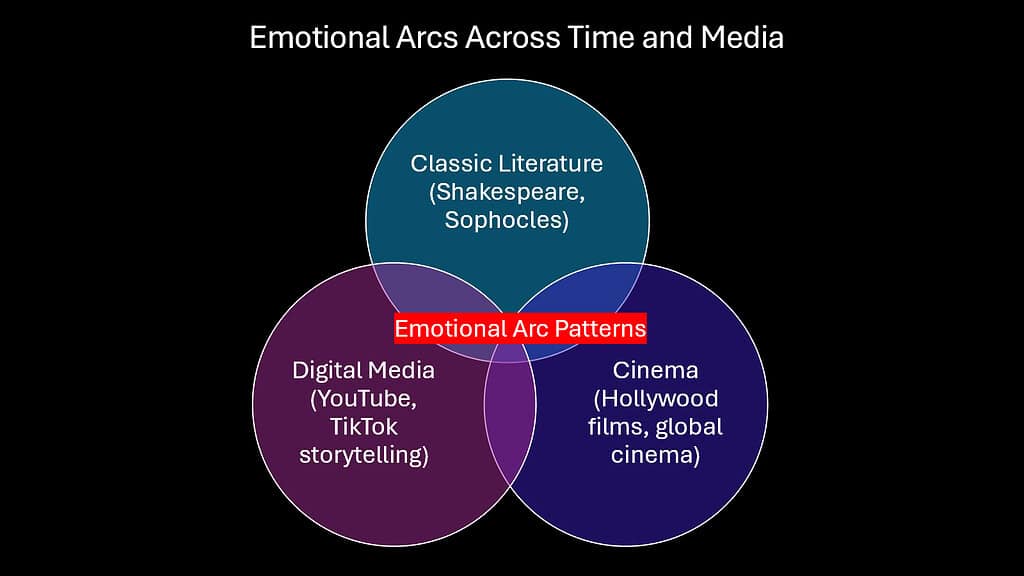
The six emotional arc patterns examined throughout this exploration reveal storytelling’s most fundamental truth—narratives derive their power not from clever plots or memorable characters alone, but from their ability to guide audiences through carefully orchestrated emotional journeys. These patterns represent the deep architecture of human psychological response, mapping territories of hope, fear, triumph, and despair that remain constant across cultures and centuries.
Understanding these patterns transforms how we appreciate both classic literature and contemporary media. When we recognize the rise-fall-rise pattern in Star Wars or identify the fall-rise-fall structure in Breaking Bad, we see beyond surface entertainment to encounter sophisticated psychological instruments designed to process complex human experiences. These patterns provide frameworks for understanding not only fictional narratives but the stories we tell ourselves about our own lives.
The persistence of these emotional arc patterns across different media and historical periods demonstrates their connection to fundamental aspects of human psychology. From ancient Greek tragedies to modern streaming series, from oral storytelling to interactive narratives, digital storytelling to graphic narratives, these six patterns continue to shape how stories create meaning and memory. Their universality suggests deep evolutionary origins in human emotional processing and social learning.
Modern storytelling has expanded and refined these classical patterns while maintaining their essential psychological functions. Contemporary narratives address current concerns about technology, identity, relationships, and social justice while employing emotional arcs that remain rooted in timeless human experiences. This combination of ancient wisdom and modern relevance ensures continued cultural vitality.
The practical applications of emotional arc understanding extend beyond entertainment into education, therapy, marketing, and personal development. Recognizing these patterns helps individuals better understand their own life experiences and emotional responses. It provides tools for processing difficult experiences and frameworks for imagining positive change and growth.
As storytelling continues evolving through new technologies and cultural shifts, these emotional arc patterns will likely adapt while retaining their core psychological functions. Virtual reality, interactive media, and artificial intelligence may create new storytelling possibilities, but the fundamental human need for emotional processing through narrative remains constant. Understanding these timeless patterns provides essential preparation for whatever storytelling innovations the future may bring.
Emotional Arc Patterns and Their Enduring Cultural Impact
| Emotional Arc Pattern | Primary Psychological Function | Cultural Role | Memory Formation | Modern Applications | Universal Appeal |
|---|---|---|---|---|---|
| Rising Fortunes | Validates hope and possibility | Inspires social mobility | Strong positive associations | Self-help and motivation | Dreams of betterment |
| Falling Fortunes | Processes fear and mortality | Explores human limitations | Deep emotional catharsis | Social criticism and warning | Shared vulnerability |
| Fall and Rise | Models resilience and recovery | Demonstrates redemption | Balanced complex memory | Trauma and addiction narratives | Comeback stories |
| Rise and Fall | Warns against hubris | Critiques unchecked ambition | Cautionary emotional impact | Celebrity and power studies | Success anxiety |
| Rise-Fall-Rise | Celebrates perseverance | Champions human endurance | Richly layered emotional memory | Personal development stories | Ultimate triumph |
| Fall-Rise-Fall | Confronts life’s complexity | Acknowledges tragic reality | Profound philosophical impact | Existential and artistic works | Mature understanding |

